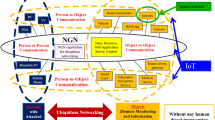Abstract
With the rapid development and extensive promotion of computer and Internet technology, users are more and more dependent on the network. The traditional information management system has been unable to meet the actual needs of a large number of concurrent access and fast storage. Therefore, it is very important to establish a unified cloud application platform for centralized management and unified identity of users in different systems. Through the combination of user experience testing technology, Internet of Things technology and cloud computing technology, the automatic user experience test of network application is realized, and the test report is generated. Managers can view the report through the report display interface provided by the user experience test cloud platform. Before the information system goes online, it will greatly improve the user experience quality of the information system by using the user experience test cloud platform. The designed pipeline integrates the augmented system and the Social Internet of Thing system to provide the efficient framework. Through the testing, the performance of the model is validated, the accuracy has reached the state-of-the-art level.



Similar content being viewed by others
References
Azuma RT (1997) A survey of augmented reality. Teleoper Virtual Environ 6(4):355–385
Berkemeier L, Zobel B, Werning S, Ickerott I, Thomas O (2019) Engineering of augmented reality-based information systems. Bus Inf Syst Eng 61(1):67–89
Caboni F, Hagberg J (2019) Augmented reality in retailing: a review of features, applications and value. Int J Retail Distrib Manag 47:1125–1140
Carr N (2008) It is no longer important: cloud computing, the commanding height of the internet transformation. Translated by Yan Xianning, vol 4. CITIC Publishing House, Beijing, pp 233–236
Formo J (2012) A social web of things [EB/OL]. http://www.ericsson.com/uxblog/2012/04/a-social-web-of-things/2012
Ibáñez M-B, Delgado-Kloos C (2018) Augmented reality for STEM learning: a systematic review. Comput Educ 123:109–123
Internet of Things in 2020: roadmap for the future [EB/OL]. [2010-03-10]. http://ec.europa.eu
Jiang H, Li L, Xian H, Hu Y, Huang H, Wang J (2021) Crowd flow prediction for social internet-of-things systems based on the mobile network big data. IEEE Trans Comput Soc Syst. https://doi.org/10.1109/TCSS.2021.3062884
Jianxun Z, Zhimin G, Chao Z (2010) Overview of cloud computing research. Chengdu Comput Appl Res 2(4):429–433
Ke S, Jianguo J, Taile P (2007) Research and implementation of augmented reality one-way physical interaction technology. J Huaibei Coal Norm Univ 28(4):52–55
Khan T, Johnston K, Ophoff J (2019) The impact of an augmented reality application on learning motivation of students. Adv Hum Comput Interact. https://doi.org/10.1155/2019/7208494
Khanfor A, Ghazzai H, Yang Y, Haider MR, Massoud Y (2020) Automated service discovery for social internet-of-things systems. In: 2020 IEEE international symposium on circuits and systems (ISCAS). IEEE, pp 1–5
Lakshmanaprabu SK, Shankar K, Khanna A, Gupta D, Rodrigues JJPC, Pinheiro PR, De Albuquerque VHC (2018) Effective features to classify big data using social internet of things. IEEE Access 6:24196–24204
Liu L, Li H, Gruteser M (2019) Edge assisted real-time object detection for mobile augmented reality. In: The 25th annual international conference on mobile computing and networking. pp 1–16
Peng L (2010) Cloud computing, vol 3(4). Electronic Industry Press, Beijing, pp 180–185
Pintus A, Carboni D, Piras A (2012) Paraimpu: a platform for a social web of things. In: Proceedings of the 21st international conference companion on World Wide Web. ACM, pp 401–404
Premarathne US (2017) MAG-SIoT: a multiplicative attributes graph model based trust computation method for social Internet of Things. In: 2017 IEEE international conference on industrial and information systems (ICIIS). IEEE, pp 1–6
Radu I, Schneider B (2019) What can we learn from augmented reality (AR)? Benefits and drawbacks of AR for inquiry-based learning of physics. In: Proceedings of the 2019 CHI conference on human factors in computing systems. pp 1–12
Shen J, Zhou T, Wei F, Sun X, Xiang Y (2017) Privacy-preserving and lightweight key agreement protocol for V2G in the social Internet of Things. IEEE Internet Things J 5(4):2526–2536
The Internet of Things [EB/OL]. [2010-03-22]. http://www.itu.int
Wang X, Zhong X, Li L, Zhang S, Lu R, Yang T (2020) TOT: Trust aware opportunistic transmission in cognitive radio social Internet of Things. Comput Commun 162:1–11
Yao Y, Pang XX, Liu T, Hu QX (2009) Prototype design of bone defect repair system based on augmented reality. Comput Eng 35(23):15–20
Funding
The paper is supported by the following projects. 1. Hunan Philosophy and Social Science Fund Project "Research on the Five-in-One Cultivation Model of Cultural Industry Talent Double Chain Integration" (Project Number: 18YBA117). 2. Scientific Research Project of Hunan Provincial Department of Education "Research on the Development Model of Hunan Digital Animation Industry UGC in the Era of Production and Consumer Integration" (Project Number: 18B550).
Author information
Authors and Affiliations
Corresponding author
Ethics declarations
Conflict of interest
There is no conflict of interest.
Additional information
Publisher's Note
Springer Nature remains neutral with regard to jurisdictional claims in published maps and institutional affiliations.
Rights and permissions
About this article
Cite this article
Dai, B. Cloud information experience platform based on augmented reality in the background of Social Internet of Things. Int J Syst Assur Eng Manag 13, 998–1004 (2022). https://doi.org/10.1007/s13198-021-01376-5
Received:
Revised:
Accepted:
Published:
Issue Date:
DOI: https://doi.org/10.1007/s13198-021-01376-5




